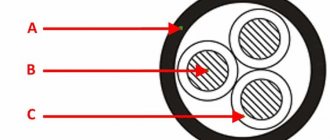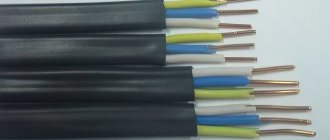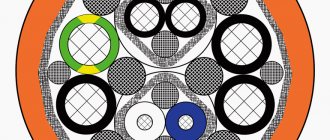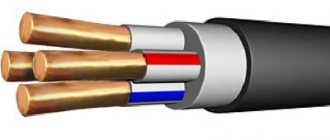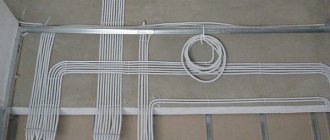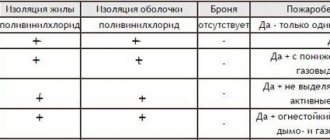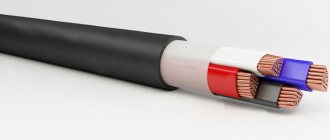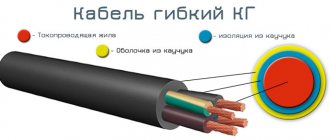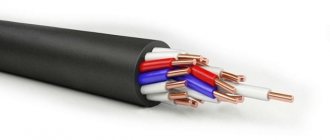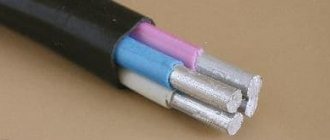Today there is a huge selection of cable products, and not even all electricians can thoroughly understand their designations and names without special literature.
The first question that arises before a consumer who decides to repair the electrical wiring at home is which cable should I choose? Let's consider only those types of cable that most often need to be used when installing and replacing electrical wiring inside an apartment or house. Finding them in construction stores is not difficult.
However, when purchasing, you must know exactly what their letters in the abbreviation mean, when you need to use one or another brand, and whether it is possible to replace one cable with another if one of the types is not on sale.
Cable VVGng and VVGng-LS differences
The first most common and most correct cable option is VVGng and its variety VVGng-LS. The cable has the following design:
It can be single-core or multi-core. In this case, the conductor was single-wire up to a cross-section of 25mm2. Most often it has a flat shape, which is very convenient when placing it in a narrow groove in a vertical position.
And in plastic cable channels it is convenient to lay wires of this particular shape. At the same time, do not forget that there should still be 40% free space in the cable channel after installation.
NYM – confidence for many years
This is a German analogue of the VVG cable. Only it is manufactured in accordance with the German standard DIN VDE Normenleitung. It is characterized by high reliability, safety and long service life - up to 40 years. It is most often chosen for installation in apartments, cottages, office buildings, commercial and industrial premises. Many manufacturers offer frost-resistant cables, the operating temperature of which can reach -50 °C. Therefore they are suitable for installation in unheated rooms. Also, the NYM sheath is not afraid of ultraviolet radiation, unlike VVG - you can install the cable where direct sunlight hits. It is also easy to cut without special tools, which electricians appreciate.
Understanding the labeling
- N (normenleitung) – manufactured according to VDE standard
- Y (ysolationsschicht) – polyvinyl chloride insulation
- M (mantelleitung) – there is an outer shell
This type of cable can have from 1 to 7 copper cores. The cross section can reach 6 square meters. mm. You can find a product marked ls (low smoke), which means reduced smoke production when heated. The letter J indicates the presence of a yellow-green protective ground conductor. If there is no letter after the name or there is the letter O, this means there is no grounding conductor.
Explanation of the name
First of all, let's decipher all the letters in the abbreviation. Many people often wonder what they mean?
In the first
means that the insulation is made of polyvinyl chloride material
In the second
The cable sheath is also made of polyvinyl chloride insulation
G
cable Bare, without any protective armor covering
Just to remember, electricians call it among themselves:
Vinyl-Vinyl-Naked
Some brands after VVG have additional letters in their names:
P
stands for “flat”
ng
means that the cable is not flammable, although it would be more correct to say “non-flammable”
A
the cable is not flammable even when laid in bundles
Non-flammable due to the use of special insulation that does not support combustion, both the main core and the outer sheath. During a short circuit, such insulation envelops the wires and prevents them from burning.
Many people mistakenly talk about adding a chalk mixture to the insulation of the cores of a given cable, supposedly to reduce flammability. There's no chalk there.
Only dye is added to the insulation itself, otherwise you won’t get a quality product.
The only purpose for which a chalk-filled mixture can be used is exclusively to separate the insulation from the shell.
To do this, the veins are pre-rolled in a chalk bath during the production process. In addition, this technology helps prevent the cores from sticking together inside the shell.
Remember that the property of not burning a cable is only part of the task. It is necessary that the fire dies out and dangerous combustion products do not spread, and for this it is necessary to displace oxygen from this very zone. The PVC casing of VVGng-LS contains chlorine and other additives that perform this function.
It is because of this that the VVGng-LS brand is primarily recommended for installing wiring inside a house, office, or apartment.
L.S.
this is an abbreviation for Low Smoke, that is, low smoke and gas emissions
Common Features for These Cables
According to clause 4.1 a)-e) GOST 31996-2012, the general characteristics for these VVG cables are:
clause 4.1 a) according to the material of current-carrying conductors: copper conductors (without designation);
clause 4.1 b) by type of insulation material of current-carrying conductors: insulation made of polyvinyl chloride plastic, including reduced fire hazard (B);
clause 4.1 c) by the presence and type of armor: unarmored (D),
clause 4.1 d) according to the type of material of the outer sheath or protective hose: made of polyvinyl chloride plastic, including reduced flammability or reduced fire hazard: outer sheath (B),
e) by the presence of a metal screen: without screen (without designation);
Specifications
All technical data of the most used cable sections VVGng-LS, such as rated current, weight, resistance are presented in the tables below:
One important tip - even if you don’t yet have a grounding wire in your house and the system is TN-C and not TN-CS, still always buy only a three-core cable.
This way you won't have to redo all the wiring if you change your grounding system. Well, as a last resort, the third core will always remain a backup if a break occurs on the phase or neutral wire.
Various indications for these cables
According to clause 4.1 e)-g) GOST 31996-2012 decoding for these cables VVG, VVGng(A) and VVGng(A)-LS:
f) on performance in terms of fire danger indicators:
- flame retardant when installed alone (no designation);
- flame retardant during group installation (ng): according to category A - ng(A),
- flame retardant when installed in groups, with reduced smoke and gas emissions (ng-LS);
g) according to the cross-sectional shape of the cable:
- round (no designation);
- flat (P).
In accordance with clause 6.3.2, cables of versions “ng” and “ng-LS” should not spread fire when laid in groups. Test category A is established in the technical specifications for cables of specific brands.
According to clause 6.3.3, cables of “NG-LS” versions must have low smoke and gas emissions during combustion and smoldering.
Residential use
People often wonder, is it possible to use a simple VVGng, without the LS index? The rules, which have changed significantly in recent years, say that for installation inside residential premises, simple VVGng is prohibited.
This brand can only be used outside the building. See GOST 31565-2012 –.
This is explained by the fact that although it does not burn, under the influence of a flame it releases a huge amount of toxic substances. But it is because of combustion products, and not from fire, that most people die in fires.
Which type is suitable for different rooms?
It is better to install hidden wiring in an apartment using NYM. It is more plastic, easier to fit into prepared grooves. Rubber-reinforced insulation reduces the risk of experiencing possible floods. It is especially often used where there is excess moisture, for example, a kitchen, bathroom or toilet. For these installation purposes, it is worth choosing an NYM cable, as it will provide the necessary safety measures.
It is not recommended to use NYM outdoors, for laying in the ground, because it has low resistance to changes in soil activity. In practice, Russian factories produce NYM wire according to their own specifications, and not according to the original VDE recommendations. In terms of manufacturing, the cable is not much different, but at the same time, the appropriate quality of the filler may not match, it will leak out, and the cable will fail.
If you need to install it in a house built of wood, remember that hidden wiring in such buildings is laid in metal pipes.
With an open method of installing electrical wiring, you need to choose VVGng, since its characteristics are not so susceptible to ultraviolet radiation, and in case of a fire in closed premises, VVGng-ls, which practically does not emit dangerous smoke, shows itself to be more effective. The cable is filled with non-vulcanized filler, which has an increased oxygen index (OI) and shows a minimum oxygen composition when creating combustion conditions. This is why the fire safety of the cable increases. But when laying as part of a group, it is more advisable to take the VVGng cable.
When the operational features of conductor products are not decisive, and there is simply a question of choice, it is advisable to give preference to a more budget-friendly product. The cost of NYM exceeds the cost of VVGng by at least 10-12%.
NYM cable differences
The next brand suitable for indoor wiring is NYM cable. This designation is international and came to us from Germany.
The letter N (Normenleitung) means compliance with the German VDE standard - the union of German electricians. Y (Isolierung der Adem aus Polyvinylchlorid) – core insulation material is polyvinyl chloride, just like VVG. M (Mantelleitung) – installation cable with a protective sheath for installation inside buildings and structures
There are also similar names NUM and NUM. These are not fakes at all, as they might seem at first glance. They are produced by the same factories according to their own technical specifications, but without a VDE certificate.
Technical specifications:
NYM can be called a foreign analogue of VVGng, although another brand, VVGz, is closer to it. “Z” is a placeholder.
Choose a GOST or TU cable?
In a separate article, we looked at the differences between GOST and TU cables. In short, any cable is manufactured according to the technical specifications of the plant (abbreviated as TU). This means that the manufacturer declares certain conditions that the cable meets (resistance per 1 km of cable, sheath and insulation materials, filler, type of metal, etc.). At the same time, each plant has the opportunity to obtain compliance of its plant’s specifications with the state standard (abbreviated GOST).
If a plant receives GOST for its products, this means that the cable production plant’s specifications comply with the GOST standard. In common people, the cable that does not pass certification is called TU (because the cable complies with the Technical Conditions of the plant, but does not comply with GOST), and the cable that has passed certification is called GOST (that is, the plant’s specifications comply with GOST).
Very often we are asked the question - what to take, GOST or TU? This decision remains primarily yours. We, for our part, believe that the optimal cable in terms of quality-price ratio is the VVGng GOST cable - that is, a flat cable without filler, but made in accordance with GOST. It is more than enough for household needs.
What is the difference between NYM and VVGng
Here are the main differences between the two cable brands:
- firstly it has triple insulation
The third intermediate layer, in addition to fire-fighting properties, also restrains mechanical stress between the external insulation and the conductors. This prevents the formation of cracks on them.
True, the manufacturer himself does not consider this third layer of extruded rubber mixture to be insulation. And judging by the test voltage, the insulation itself is somewhat inferior here:
VVGng - test voltage - 3 kV NYM - test voltage 2.5 kV
- secondly, its insulation is gray, while that of VVG is black
For many, categorically black may not be suitable for aesthetic purposes.
- thirdly, it is always round in shape
A plus that few people think about, but the rounded shape of NYM makes it easier to seal the input of this cable into various devices, junction boxes and cabinets.
- and most importantly, the NYM cable is suitable for fire safety for indoor premises only when installed individually!
If you want to lay it in bunches of two or three pieces in one groove or channel, you will have to use the NYMng (A)-LS modification
Just don’t be confused, single NYMs, each laid in a separate corrugation, and running along the surface of a wall or ceiling next to each other, are not considered a bundle. This is exactly how many electricians get around the ban on group installation of wiring of this brand.
Difference between VVG or NYM
What is the difference between VVG and NUM? These cables differ: - color
(VVG cable is black, and NYM cable is gray)
- shape
(VVG, can be flat and round, NUM is always round)
- operating temperature
(VVG from -50 to +50, NUM from -30 to +40)
- shell material
(VVG - PVC, NUM - polyvinyl chloride)
- presence of filler
(in the standard version, VVG does not have filler, but NYM always has it)
- reaction to direct sunlight
(VVG is more stable, NUM is less stable)
Cable laying features
Of course, this wire does not spread combustion, but this does not mean that it does not burn at all.
Here is a demonstration video about the simultaneous testing of the flammability of two brands when exposed to an external flame. It immediately becomes clear why NYM cannot be laid in bundles and together with each other.
Another feature of this brand, which at the same time can be its disadvantage, is that the cable insulation is afraid of ultraviolet rays. That is why it cannot be laid outside.
VVGng has greater opportunities here. It can be easily used both inside and outside the building. For example, as an input from a pole to a house, or a branch after a SIP wire.
A close relative of NYM, which can be used outdoors and outdoors, since its insulation is no longer afraid of ultraviolet radiation, is the MMJ cable.
Why do many still choose NYM given its relative disadvantages? This is explained by the great convenience when laying it - it is easier to clean, bends at turns, and does not get stuck when pulled through pipes and corrugations.
For a flat VVG cable, you need to make sure that it does not get twisted, but with a round NYM there are no such problems.
Application area
NYM cable can be used in various climatic zones, inside production facilities with low or high humidity levels, in domestic and living rooms and even outdoors.
When installing outdoors, it is important to avoid direct exposure to ultraviolet rays of the sun. Inside residential buildings, wire is used in different cases: both with open and hidden wiring. It is used to switch lighting equipment, electrical sockets, switches and other devices. When installing a line in open ground, the cable must be protected using corrugated pipes or special boxes. When laid aerially, NYM is reinforced with high-quality overpasses. For any electrical devices that require a seal at the input, it is best to use just such a cable.
Differences in the field of application of cables according to fire hazard
The scope of application of cables for fire hazard is given in GOST 31565-2012 “Cable products. Fire safety requirements."
This GOST 31565 applies to cable products that are subject to fire safety requirements, intended for installation in buildings and structures, and establishes classification, fire safety requirements, and preferred areas of application. GOST 31565 does not apply to cable products intended for installation in land and water, as well as to oil-filled cables, winding and bare wires.
Let us highlight the main differences in the use of VVG, VVGng(A) and VVGng(A)-LS cables in accordance with GOST 31565.
According to Table 2 of Section 6 “Preferential areas of application of cable products, taking into account their type of execution”:
| Type of cable product | Fire hazard class | Preferred area of application |
| Without designation | O1.8.2.5.4 | For single installation in cable structures and industrial premises. Group installation is permitted only in outdoor electrical installations and industrial premises, where only periodic presence of maintenance personnel is possible, and passive fire protection must be used |
| ng(A) | P1b.8.2.5.4 | For laying, taking into account the volume of flammable load of cables, in open cable structures (overpasses, galleries) of external electrical installations |
| ng(A)-LS | P1b.8.2.2.2 | For laying, taking into account the volume of flammable load of cables, in internal electrical installations, as well as in buildings, structures and closed cable structures |
Brief explanation of VVG cable markings in the video:
Color of conductors in the cable according to PUE 7, GOST R 50462 and GOST 31996
Requirements for cables according to PUE
Cables VVG 3x1.5 and 3x2.5 requirements for cores according to GOST and TU
Practical advice
- If permanent wiring is being laid, it is better to use a cable with current-carrying cores made of single wires. It is smaller than stranded wire, susceptible to corrosion (due to its smaller surface area), and is easier to clean before connecting.
- Rubber, under the influence of ozone contained in the air, ages and becomes covered with microcracks. Therefore, it is advisable not to use rubber-coated cables in sunny locations. Armored options and laying cables in the ground are preferable.
- Polyvinyl chloride is prone to cracking in severe frost, so it is better to use polyethylene-coated cables outdoors.
- Firefighters do not like polyethylene, so stabilized self-extinguishing polyethylene is preferred indoors (in the wire brand it is designated as Ps).
- Lead-sheathed cables are best laid in the summer. In the cold, when they bend, due to the low frost resistance of lead, microcracks may form.
- Cables AVVGng, VVGng, AVBbShng and VBBShng are distinguished by a sheath or hose made of low-flammability PVC plastic. Used in places with increased fire hazard.
- If you are going to run the cable in an aquatic environment (for example, to connect pumps in wells or to power a summer fountain on the site), you will need a special brand of runway for submersible motors. The disadvantages of this model include the fact that the cable is produced as a single-core cable. This means that to connect a pump or fountain you will have to use two wires twisted together (so as not to get tangled). As an alternative, you can consider using a French-made Lyonipompe cable. It is three-core, with a cross-section from 1.5 to 4 mm2.
- For temporary connection, it is advisable to use multi-core cables of the KG and PVS brands (KG - with copper stranded conductors, equipped with rubber insulation, in a rubber sheath), for permanent connection: along the street - VVG, for laying in the ground - VBbShV with protective armor.
- If the cable needs to be routed through flammable materials (such as the walls of your wooden house or oil-containing substances in your garage), its designation must contain the letters “N” (non-flammable) or “ng” (flame retardant). These are, for example, cables kgN and VVGng, which, by the way, are best used not only in wooden houses (on the issue of the “cat house”).
- If the site has neutral soil with deep groundwater, then cables of the AVVGz and VVGz brands are suitable for you, recommended for installation in soil with low corrosive activity in the absence of the possibility of mechanical damage and tensile stress. If the area is swampy and the ground on the site is heaving (this is revealed, for example, by the fact that a garden bench dug shallowly in the fall turned out to be skewed in the spring; fence posts, etc. can behave in a similar way), then it is better to use cables of the AVBbShv and VBbShv brands (polyvinyl chloride along the core, polyvinyl chloride sheath, armor made of galvanized steel strips, a sealed external hose on top), designed for any operating conditions and resistant to mechanical damage.
- In addition, you should know what voltage is in the network and how many phases are used in your area. If 220 V and 1 phase, then a two- or three-core cable is suitable (the third core - “ground” - usually has a smaller cross-section than the others). If there is 380 V and three-phase current (which is required for the operation of some pumps and motors), then a three-core (identical cores) or four-core cable is required (the fourth core is “ground”). This is reflected in the product labeling. For example, kg - 42.5 means a four-core cable with a cross-section of the main cores of 2.5 mm2.
VVGng-HF
VVGng HF is a power cable used for conducting and installing AC power networks with voltages of 660V and 1000V. First of all, the VVGng HF cable is recommended for organizing power supply for lighting and electrical equipment at large industrial and public facilities: power plants, factories, petrochemical industry facilities, stadiums, concert halls, train stations, airports, educational and medical institutions, shops and other buildings with increased requirements to fire safety.
Characteristics of VVGng HF cable:
- rated voltage: up to 1 kV;
- operational ambient temperature range: -30˚C – +50˚C;
- cable laying temperature (without heating): not lower than -15˚C;
- relative humidity in the room (at +35˚С) – up to 98%;
- maximum heating of cores during operation: up to 70˚С (up to 90˚C in PVVGng);
- maximum heating of cable cores during overload: up to 90˚C (up to 130˚C in PVVGng);
- maximum permissible temperature for prolonged exposure – 400˚C;
- the smallest permissible bend radius of the wire during installation: 10 diameters for single-core cables and 7.5 for multi-core cables;
- service life – 30 years.
Advantages and disadvantages
Among many conductors, NYM cable is considered to be the “golden mean”. To better understand its quality, let’s consider the main advantages of this product:
- Increased elasticity, ease of installation and operation. This flexibility is due to the presence of an internal insulating layer of rubber. This advantage is very important when performing any installation work on electrical wiring, as well as when installing equipment in inaccessible or hard-to-reach places. The wire is not affected by dampness and moisture, so it can be laid along the ground over long distances.
- If we talk about NYM, manufactured according to German quality standards, then before entering the market it must undergo numerous studies and tests. The Germans have long earned the title of the most reliable and high-quality manufacturers of industrial and other products, so there is no doubt about the integrity of the insulation and the compliance of the cable with all the declared technical and operational properties.
- The product does not support combustion, which was made possible due to the choice of material for the inner layer.
- Most specialists and electricians recommend using the product to connect lighting systems and power circuits.
- Long service life spanning several decades.
The most obvious disadvantage of NYM cable is its high cost. There are many domestic analogues, albeit with worse characteristics, the prices of which are several times lower.
Types of electrical cables
If we consider exclusively cables for power electrical circuits, the main types here are the following power cables:
- VVG;
- KG;
- VBBShv.
Of course, this is not a complete list of all existing cable products. However, using the technical characteristics as an example, you can form a general idea of the electrical cable.
Execution under the VVG brand
Widely used, popular and reliable brand. The VVG cable is designed to transmit current with a voltage of 600 - 1000 volts (maximum 3000 V).
The product is manufactured in two modifications, with current-carrying conductors of a solid structure or a bundle structure.
Product from the category of electrical cables, noted as popular and often chosen as the material for constructing electrical power lines
According to the product specification, the range of core sections is 1.5 - 50 mm. PVC insulation allows the cable to be used at temperatures of -40…+50°C.
There are several modifications of this type of cable products:
- AVVG
- VVGng
- VVGp
- VVGz
The modifications are distinguished by a slightly different design of insulation, the use of aluminum conductors instead of copper conductors, and the shape of the cable.
Power flexible cable type KG
The design of another popular cable, characterized by a high degree of flexibility due to the use of a bundle structure of current-carrying conductors.
Design of the KG brand flexible power cable for four working current-carrying conductors. The product has high quality insulation and demonstrates good technical characteristics
The design of this type provides for the presence of up to six current-carrying wires inside the shell. Operating temperature range -60…+50°С. Mainly, the KG variety is used to connect power equipment.
Armored cable VBBShv
An example of the design of special cable products in the form of a product under the VBBShV brand. The conductive elements can be bundled or solid conductors. In the first case, the range of sections is 50-240 mm2, in the second it is 16-50 mm2.
The cable insulation is constructed by a complex structure, including belt insulation, tape screen, steel armor, bitumen and PVC.
The structure of the power cable for high voltage and significant power. This is one of those cable product options, the use of which guarantees the reliability of the circuit
There are several modifications of this type:
- VBBShvng – non-combustible insulation;
- VBBShvng-LS – does not emit harmful substances when burning;
- AVBbShv – the presence of aluminum conductors.
The ability to read cable product markings is useful when selecting products and wiring electrical networks.
Alphanumeric marking of the cable product: 1) letter 1 – core metal; 2) letter 2 – purpose; 3) letter 3 – insulation; 4) letter 4 – features; 5) number 1 – number of cores; 6) number 2 – section; 7) number 3 – voltage (nominal) (+)
Features of the type of core material – Letter 1: “A” – aluminum core. In any other case, the vein was copper.
As for the purpose (Literature 2), the decoding here is as follows:
- “M” – for installation;
- “P(U)”, “MG” – flexible for installation;
- “Ш” – installation; “K” is for control.
The designation of insulation (Liter 3) and its interpretation is as follows:
- “V(VR)” – PVC;
- “D” – double winding;
- “N (NR)” – non-flammable rubber;
- “P” – polyethylene;
- “R” – rubber;
- “C” – fiberglass;
- “K” – nylon;
- “Ш” – silk polyamide;
- “E” – shielded.
The features indicated by Letter 4 have their own interpretation:
- “B” – armored;
- “G” – flexible;
- “K” – wire braid;
- “O” – the braid is different;
- “T” – for pipe laying.
The classification also provides for the use of lowercase letters and Latin letters:
- “ng” – non-flammable,
- “z” – filled,
- “LS” – without chemicals. combustion emissions,
- “HF” – no smoke when burning.
Markings, as a rule, are applied directly to the outer shell, and along the entire length of the product at regular intervals.
Table of symbols of the most used types of wires and their compliance with standards. It is always possible to determine the brand by simply reading directly from the product shell (+)
On our website there are articles devoted to the choice of cable products for arranging electrical networks in an apartment and house, we recommend that you read:
- Which cable to use for wiring in an apartment: overview of wires and choosing the best option
- Which wire to use for wiring in the house: recommendations for choosing
- Which cable to use for wiring in a wooden house: types of non-flammable cable and its safe installation
Advantages of VVG cables
Due to their excellent technical characteristics, VVG brand power cables have the following advantages:
- Ensuring high quality of transmitted electricity. The main task of any power transmission system is to preserve the quality indicators of electrical energy as much as possible. To do this, the conductors of such a system must have such technical characteristics as low active and reactive resistance, as well as high quality insulation. Today, copper is one of the best materials for use in this type of system.
- Non-flammability. Allows the use of wires of this type in rooms with increased fire hazard.
- High tensile strength of insulation. It makes it possible not only to protect the electrical network from short circuits in the event of unintentional mechanical impacts on the wires, but also provides ease of wiring installation, as well as the operation of electrical appliances. In addition, VVG brand products are characterized by increased resistance to mechanical vibrations.
- High dielectric properties of PVC insulation. This makes it possible to produce reliable and powerful cables of relatively small diameter. According to regulatory documents, each VVG copper power cable is tested with increased voltage, the value of which, depending on the rated voltage of the cable, is 3 or 3.5 kV.
- Moisture resistant. Although such products are not designed for installation in water, their insulation is quite resistant to moisture. This allows the use of cables of this type in places with high humidity (reaching 98%), which include bathrooms, toilets, kitchens, showers, etc.
- High reliability. VVG power cable laid in protective systems, such as special cable ducts, corrugated tubes or cable runs, is characterized by exceptionally high reliability.
- Long service life. According to the technical specifications, the minimum service life of this cable is 30 years.
- Wide range of models. A large selection of cross-sections of copper and aluminum conductors allows you to accurately select the required cable diameter to power electrical installations of a certain power. This makes it possible to significantly save money when designing and installing electrical wiring. In addition, the ability to use VVG-P (flat) cables allows you to achieve maximum convenience when performing installation work.
- Convenient color and digital marking of current-carrying conductors. The phase wire has white, red or brown insulation, the neutral wire is blue, and the ground wire is yellow with a green stripe.
Conclusions and useful video on the topic
The main thing about electrical wiring in a fire-hazardous house:
The correct selection of cable for wiring in a wooden house is the key to the safety of its inhabitants. Due to the increased fire hazard of such a structure, it is necessary to use cable brands with a high degree of reliability .
One should not miss the point that cables and devices should not come into contact with wood. Provided that the wiring is wisely selected and carried out taking into account the recommendations, the efficiency, durability and safety of the wiring can be guaranteed.
Tell us about how you selected a cable to supply a country wooden house with electricity. Share interesting technological nuances that will be useful to site visitors. Please leave comments in the block below, ask questions, post photos on the topic of the article.
What do you need to know about cable cross-section?
This parameter is determined based on the current strength. If the cross-section and loads do not match each other, short circuits will occur, resulting in a fire. So, if the plans include closed wiring, and the estimated current is 16 A, a cable with a minimum cross-section of 2 mm² is required. With a rated current of 25 A - 4 mm².
Select cables according to distribution groups and depending on the expected load. In order to connect the sockets, you will need a cable with copper conductors with a cross-section of 2.5 mm². The maximum total power is 4.6 kW.
Lighting devices are powered by a cable with a cross section of 1.5 mm². The power of this group is up to 3.3 kW. Therefore, the number and location of light sources must be planned before installation begins - when drawing up an electrical circuit
High-power home equipment is connected with a cable having a cross-section of 4 mm². Such devices must be connected to an individual outlet and cannot be connected to another group.
Life time
The estimated service life of VVG and NYM cables is at least 30 years.
At the same time, the wording “not less” means that if this cable is under 100% load in unfavorable conditions, it must work for AT LEAST 30 years.
And if there are the most ordinary conditions and the absence of a nominal load, then maybe all 50! It is these two main brands of cable, discussed in detail in the article, that are the most suitable and popular for installing electrical wiring, connecting sockets, switches and lighting.
There is another brand different from the two above that you may need in small quantities. But this is not a cable, but a wire - PV-3.
It is flexible, multi-core, easy to bend in small spaces and convenient to connect to machines via NShVI lugs. That is why it is used in the assembly of electrical panels.
Well, in the end, we will give a decoding of all the meanings of the letters in the cable brands, which are widely applicable in our electrical networks.
Tips for safe styling
Both the choice of materials, the method of laying wiring, and the method of installing installation products in a wooden house have their own specifics. The priority issue is safety.
What standards must the wiring comply with?
If the base is flammable, installation must be carried out using an open method or the conductor must be localized by enclosing it in a protective sheath.
In the case where the internal partitions in the house are framed, equipped with non-flammable filler, the cable is usually placed in a metal hose or corrugation. A more correct solution would be to encase the racks through which the cable passes
An important point is to ensure good access to the cable when placing it in a protective casing.
Even if the wiring in a wooden house is carried out by experienced electricians, in order to evaluate their work, you need to know three basic rules for it:
- Prevent even the possibility of fire of electrical cables or at least reduce it to a minimum. In any case, they must not transmit open fire to wooden elements in the event of a short circuit. (short circuit) in the electrical circuit. Therefore, the wires should not come into contact with the wooden surface.
- The cable parameters must be 100% compliant with the PUE and have a power reserve to easily withstand maximum loads. Any degree of heating of the terminal connections and input cable is unacceptable.
- Electrical wires must be in perfect technical condition to eliminate the slightest chance of electric shock to the inhabitants of the house.
Safety rules cannot be pushed into the background for the sake of the aesthetic component. The consequences may be irreversible. All wiring branches in a wooden house must be equipped with circuit breakers and other protective shutdown devices.
Subtleties of cable entry into a wooden house
There are two key ways to enter a non-flammable cable for its further wiring in a wooden house while maintaining safety. The first is laying underground . The method is reliable because the cable is protected from external influences.
A significant disadvantage is the excavation work associated with the construction of a trench at least 0.8 m deep. This comes with additional financial costs.
The second method is overhead wiring . A permit is required here, and without it you cannot work on electric poles. Therefore, the work can only be carried out by suitably qualified electricians.
The diameter of the cable on the section pole - house cannot be less than 16 mm. Here it is better to use self-supporting aluminum wires with good insulation and a service life of 25 years. It is impossible to continue the line with such a wire - a copper conductor is needed for the premises.
If there is no project, then before introducing electricity into a wooden house, it is necessary to calculate the load in case of operation of all electrical appliances
The actual insertion is carried out in a metal sleeve. To do this, make a hole in the wall, fix a pipe in it, and lay a cable inside it. The space that remains is filled with cement mortar. You can soak tow in the solution and use it as a pipe filler.
The cable is attached to the wooden wall using special clamps. They provide good non-oxidizing contact. If a cable is used to suspend the cable, an eye bolt is installed to secure it to the enclosing structure.
It is not permissible to install the cable under tension. It must hang freely along its entire length, and before inserting it into the wall, it must be positioned below the hole. Otherwise, atmospheric moisture will penetrate the cable into the house. You cannot overtighten the cable itself.
The rules also regulate the thickness of the pipe walls. A powerful cable requires protection up to 1 cm thick. When the cable cross-section does not exceed 4 mm, a sleeve with walls of 2.8 mm is sufficient. This rule is used for all wiring in the house.
Nuances of installation in the area up to the switchboard
This is also one of the important areas of electrical wiring. Its specificity lies in the fact that from overloads during a short circuit. it is not protected by automatic protection. The problem is solved by the following option: for a section up to 3 m long, the cable is placed entirely in a metal pipe.
The machine can be placed outside the log house in a protected casing. This option is reliable, although not very convenient for residents of the house
The RCD and a set of automatic devices are enclosed in a dust- and moisture-proof outdoor box immediately before entering the wooden house. Triggering occurs when the load level exceeds the corresponding parameter of the main machine located in the switchgear.
When installing the meter, the main condition must be met - to avoid breaks in the supply line. Twisting is strictly unacceptable, so only a solid cable should be used for this.
Features of laying networks inside the house
Safe electrical wiring inside the house can be done in two ways: open and hidden. The first is simpler, but may not always match the style of the premises. But a hidden installation option, made in accordance with electrical safety requirements, will cost more.
Open Wiring Methods
There are several ways to install open wiring. All of them are safe; they are often chosen according to the design style. There are many overhead electrical installation products on sale for laying open wiring, and there are installation techniques that can help add some color to the interior.
In open wiring, everything is visible. All faults can be eliminated very quickly by replacing the problem area. This method was once very popular, but even now for a wooden house it is the only reasonable solution
The cable is routed inside the building along the walls and ceiling. In this case, plastic cable channels can be replaced with a corrugated polymer pipe or PV-1 wire. The twisted cord is wound around ceramic insulators, which can be a highlight of the design. Such wiring can be modernized and new lines can be laid.
There is a wide range of self-extinguishing channels on the market. You can always match them to the color and style of the room.
Hidden wiring in a wooden house
Installing hidden electrical wiring in such a fire-hazardous building is a labor-intensive process. Choosing this option can create many problems if cable repairs or network upgrades are required. However, due to the reluctance to see exposed wires and junction boxes, many people prefer hidden installation.
Such wiring should be provided for at the design stage. To ensure maximum safety, the wiring is insulated using a metal or galvanized pipe, which must be coated with paint. The cable is connected to the socket and switch through openings that are pre-protected from fire.
The hidden method of installing electrics in a wooden house is implemented exclusively in accordance with the standards. Special materials are used that serve as fire protection. The cable laid in the ceilings must be in a plastic non-flammable pipe or in a metal sleeve.
When making hidden wiring, you should keep in mind that the log house will shrink. Therefore, wood should not be allowed to interact with wires, metal or plastic channels
As practice shows, most often open and closed wiring methods are combined.
CONNECTING ELECTRICAL EQUIPMENT TO THE NETWORK
Often, during the electrical installation process, it becomes necessary to connect electrical equipment to the network, for example, an electric stove to a power outlet. For these purposes, it is convenient to use flexible wires; the main rules that must be used are the following:
Again, paragraph 2.1.48 from PUE 7, which directly indicates that it is necessary to use wires only in those areas for which they were created:
“Wires and cables should be used only in those areas specified in the standards and specifications for cables (wires)”
In other words, if the specifications for the wire indicate that “it is used for connecting electrical appliances and power tools, electric stoves, washing machines, refrigerators and making extension cords,” then it is precisely for these purposes that it must be used. This is an excerpt from the specifications for the PVS wire (Connection wire). Here, for example, such a wire is used to connect a hob.
For low-current lighting up to 24V, for example, for laying a wire from a transformer to an LED strip, ShVVP is often used - a cord with flat PVC sheaths.
The grounding conductor, for example, for an additional potential equalization system (DSUP), is quite often made from PV3 wire or its analogues.
Typically, the wires and cables listed in the article are sufficient for almost all types of work related to electrical work in an apartment or house. Such electrical wiring, if all electrical installation rules are observed, turns out to be truly reliable and safe.
Anything to add?? – leave comments!
Manufacturers of cable VVG-Png(A)
Many enterprises are engaged in the production of cable products. Among the large number of companies are the following:
Best enterprises
"Sevkabel"
The company produces products of excellent quality, regardless of their purpose. This category includes power cables, wires for overhead transmission lines, communication conductors and highly specialized products.
Cable products from
"Concord"
The company is engaged in the production of power conductors of the VVG brand with copper conductors for stationary installation in premises.
Note! Thanks to armored products, as well as low-flammability conductors from Concord, you can connect an electric heater. Manufacturer of cable products "Concord"
Manufacturer of cable products "Concord"
"Moskabelmet"
Moskabelmet produces cable and wire products for various industries. In addition, the company presents a wide range of products offered, including more than 50,000 items.
Cable and wire products company
"Podolskkabel"
There are more than 50,000 wires on the market today, divided into various categories. According to the latest data, the main consumers of manufactured products are almost all sectors of the Russian economy.
Manufacturer of cable products
Thanks to its unique technical characteristics, the VVG Png(A) conductor can be laid both outdoors and in rooms with high humidity and dryness. But in this regard, it is necessary to adhere to certain rules for installation and shelf life.
